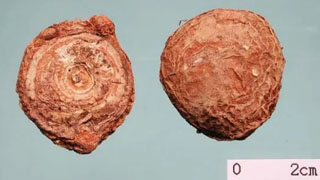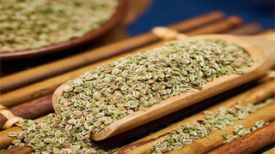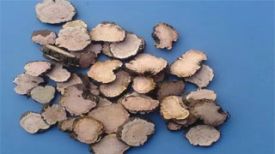
Nicknames: Banxia Jing, Guinan Xing, Hugao, Snake Taro, Wild Taro, Snake Wood Taro, Mountain Corn, Snake Baogu, Mountain Stick
Harvesting and processing: In October, dig out the tubers, remove the soil, stems, leaves, and roots, put them into a pounding bag, rub them, remove the skin, pour them out and clean them with water, scrape off the remaining skin with a bamboo knife, and finally smoke them with sulfur yellow to make them white in color, and dry them in the sun. This product is toxic, and gloves, masks, or vegetable oil should be worn during processing to prevent skin itching, redness, and swelling.
Medicinal parts: tubers
Origin: Northeast, North China, Shaanxi, Ningxia, Shandong, Jiangsu, Henan, etc
Science: Araceae
Original plant: Northeast Tiannanxing
Plant condition: Perennial herb
Height of 35-60 centimeters. The tubers are nearly spherical or flattened, with a diameter of about 2.5 centimeters, and the fibrous roots are distributed radially above.
The petiole is 17-30cm long, with a sheath in the lower one-third, purple in color; The leaves are divided in a bird footed manner, with 5 lobes (3 annual lobes), inverted ovate in shape, needle shaped or elliptical in shape, with a short pointed or sharp tip, wedge-shaped at the base, and a stem about 2cm long in the middle lobe, 7-12cm long and 4-7cm wide in the middle lobe, with a length of about 1cm in the case lobe. The common handle, the whole edge.
The inflorescence stem is shorter than the petiole, and the spatula is green or purple with white stripes; Flesh inflorescence single piece; Male inflorescence about 2cm in age, sparse flowers; The female inflorescence is about 1cm long; Each accessory has a short handle and a rod-shaped shape.
Berry red; Four seeds, red in color. The axis of the fleshy inflorescence often enlarges during the fruiting stage, and turns purple red after the fruiting stage.
Characteristics of Northeast Tiannanxing medicinal herbs: The tubers of Northeast Tiannanxing are flattened and round in shape, with a diameter of 1.5-4cm. The central stem scar is large and slightly flat, in the shape of a shallow dish, with few ring patterns. The root scars are fine and arranged irregularly, and there are slightly protruding small lateral buds around it. Mild odor, spicy taste, and a tingling sensation on the tongue.
High quality products come in large quantities. White and pink in color are preferred. Poor quality products that have not had their outer skin removed should not be used in medicine.
【 Taste 】 Bitter taste; Xin; Sexual temperature; Toxic
[Guijing] Lung; Liver; Spleen meridian
【 Indications and Functions 】 Dispelling wind and stopping spasms; Dissolve phlegm and disperse lumps. Main stroke with phlegm obstruction; The mouth and eyes are crooked at will; hemiplegia; Hand and foot paralysis; Wind phlegm dizziness; Crazy leisure; Startled wind; tetanus; Coughing and phlegm accumulation; Abscess and swelling; scrofula; Falling paralysis; Snakebite
[Usage and Dosage] Oral administration: decoct soup, 3-9g, usually used after preparation: or added to pill powder. External use: Take an appropriate amount of raw products, grind them into powder and apply them with vinegar or alcohol.
【 Attention 】 Those with yin deficiency, dry cough, extreme heat, blood deficiency and wind movement are prohibited from taking it, and pregnant women should take it with caution. Improper use of the Southern Star can easily lead to poisoning, with symptoms including oral mucosal erosion, even necrosis and shedding, numbness and swelling of the lips, tongue, throat, motor dysfunction, loss of taste, and excessive salivation; Hoarse voice, unclear speech, fever, dizziness, palpitations, numbness in limbs, and in severe cases, coma and convulsions may occur; Suffocation, respiratory arrest.
【 Discussions from Various Schools 】
1. Supplement to Materia Medica: The Southern Star intends to descend, so it is led by yellow cypress.
2. "Gangmu": The Tiger Palm of the Southern Star has a pungent and numbing taste, so it can treat wind and disperse blood; The temperature is dry, so it can overcome dampness and remove saliva; Due to its tight and toxic nature, it can attack and remove swelling to treat oral and tongue ulcers. Yang Shiying's "Zhizhi Fang" states that when all the winds are silent, it is advisable to use the Southern Star, and even add ginseng and Acorus tatarinowii to complement it. If the Southern Star is windproof, it will not be numb; if it is cowardice, it will not be dry; if it is artillery, it will not be poisonous.
3. "Compendium of Materia Medica": Pinellia ternata treats excessive dampness and phlegm, while Nanxing mainly treats excessive wind and phlegm, which is unique.
4. "Compendium of Materia Medica": The Southern Star, opening and closing. The medicine for dispersing wind and phlegm. But its taste is pungent and intense, slightly similar to Pinellia ternata, while its toxicity is even greater. The nature of Pinellia ternata is dry and slightly slow, while the nature of Nanxing is dry and quite urgent; The Xin of Banxia is capable of guarding against evil, and the Xin of Nanxing is capable of doing good deeds despite being inferior. If there is wind phlegm dampness phlegm, urgent closure of saliva phlegm, non Nanxing cannot disperse.
5. The Book of Changes: The Southern Star, also known as the Tiger Palm of the Book of Changes. To prescribe specialized medicine for clearing wind and phlegm. The "Ben Jing" treats heartache, cold and heat, and stagnation of qi, that is, it promotes qi circulation and improves the chest and diaphragm. The accumulation of hidden beams in the treatment of the "Ben Jing" is equivalent to the breaking and strengthening of the "Kai Bao". The treatment of muscle weakness and stagnation in the "Ben Jing" is equivalent to the treatment of stroke and paralysis in the "Kai Bao". The beneficial waterway of the "Ben Jing" is the same as the scattered blood abortion in the "Kai Bao". There is a saying that one thing has two names, and later generations each hold one example, which cannot be without two differences. Nanxing and Banxia are both medicines for treating phlegm. Nanxing specializes in the meridians, so it is used as a guide for stroke paralysis, while Banxia specializes in the gastrointestinal tract, so it is used as a guide for nausea, vomiting, and diarrhea.
6. The Book of Canon states: It deals with heartache, cold and heat, stagnation of qi, accumulation, lodging of beams, injury of tendons, impotence, relaxation, and diuresis.
7. "Bielu": Removing dampness and wind glare under the shade.
8. "Treatise on Medicinal Properties": Used to treat sudden changes in the wind, mainly for hernia, intestinal pain, typhoid fever, and strong yin.
9. "Herbal Collection": The main focus is on healing wounds, bruises, and blood stasis. Crush and apply to the injured area.
10. "Rihuazi Bencao": Snakes, insect bites, scabies and sores.
11. "Kaibao Bencao": It mainly deals with stroke, phlegm removal, paralysis, lower qi, rupture of hard deposits, elimination of abscesses and swelling, chest and diaphragm enhancement, and blood dispersal for abortion.
12. "Medical Origins": Remove excessive phlegm and dizziness.
13. Li Gao: The main cause is tetanus, with a silenced mouth and strong body.
14. Wang Haogu: Nourish liver wind deficiency. The treatment of phlegm is the same as that of Pinellia ternata.
15. "Gangmu": Treat epilepsy, oblique mouth and eyes, pharyngitis, tongue and mouth ulcers, tuberculosis, and craniotomy. "


